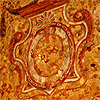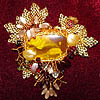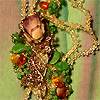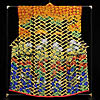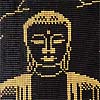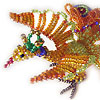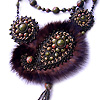November, 2009

Holiday Season is coming!Thanksgiving is behind us; we're looking forward to Holiday Season! Read in our November's issue:
Legends on amber
Contact us with any questions at
info@mylovelybeads.com.
Featured artist - Miho Kanaya Antique beads Narian-Mar, Latiffa and others Brick stitch as 1-2-3 December upcoming events Best regards, MyLovelyBeads.com Team
|
Legends on amberNovember gem is amber; you can read about that sunny gem in our previous issue. The bulk of amber in the world is found in the Baltic region mostly in Russia, and much less in Poland. Amber has been found washed up on the coasts of England, Norway, and Denmark. A lesser known sources of amber are on the Mediterranean and on the Adriatic, in Netherlands, Denmark, Dominican Republic, Mexico, in the United States and in Indonesia. Many myths surround the origin of amber. Ovid in Metamorphoses wrote about Phaethon, who convinced his father Helios, the Sun God, to allow him to drive the chariot of the sun across the sky for a day. He drove too close to the earth, setting it on fire. To save the earth, Zeus struck Phaethon out of the sky with his thunderbolts, plunging him into the sea. His sisters, the Heliades, the daughters of Helios, the Sun, turned into poplar trees on the bank of the Eridanus River:
Where sorrowing they weep into the stream forever.
And each tear as it falls shines in the water, a glistening drop of amber. To the Norse, amber was the golden tears of the Goddess Freya that fell into the sea and solidified. Polish legends ascribe amber to human tears from the forty-day rain. A Kashubian legend says amber was created from very loud lightning storms. To the ancient Greeks, amber came from the apples of immortality (hence the name, "amber" from the Greek ambrotos, meaning ambrosia). From this legend, amber was believed to instill protection to its wearer and increase longevity. The Romans picked up on this, believing amber a first rate protector, so much so, the Roman Gladiators adorned their shields and weapons with it. In Christianity, Amber is thought to be tears shed by birds at Christ's death. A Lithuanian amber myth tells about the story of lost love. Perkunas, God of Thunder, was the father God and his daughter was Jurate, a mermaid who lived in an amber palace in the Baltic. One day a fisherman named Kastytis would cast his nets to catch fish from Jurate's kingdom. The goddess sent her mermaids to warn him to stop fishing in her domain. He did not stop, so Jurate went herself to demand he stop. Once she saw him she fell in love and brought him back to her amber palace. Perkunas, knowing Jurate was promised to Patrimpas, God of Water, was angered to find his daughter in love with a mortal. Perkunas destroyed the amber palace with a bolt of lightening to kill her mortal lover. Her palace was destroyed and Jurate was chained to the ruins for eternity. When storms in the Baltic stir the sea, fragments from the amber palace wash up on shore. Pieces in the shape of tears are particularly treasured, as they are the tears from the grieving goddess, as she weeps tears of amber for her tragic love. |
|
Featured artist - Miho KanayaA visit to the American Craft Museum in NYC in 1999 set Japanese bead artist Miho Kanaya on the road to artistic excellence. Eleven years ago in her native city of Kamakura, she began making bead jewelry as a hobby. Her visit to the US and to the museum, however, made her realize that beads could be used not only for mere adornment but also as an art form. The exhibiting artist who inspired her so much was Joyce J. Scott, who remains her muse. Returning to Japan, Miho learned the technique of bead weaving and embarked upon a series of four beaded pictures entitled "The Four Seasons". The four works describe not only the seasons of the year but also the seasons of life. As Miho describes it, the pictures form a continuum: "When I display the four works, you can find the story: the spring butterflies make people feel the approach of the strong colors of summer, while the summer rainbow along the stream drifts to dye the autumn forest. And when you stand in front of "Winter", you'll see the stream floating towards you." While creating the series, Miho thought that the smoothly textured bead sheets were too sensuous to be contained in frames. She delved into her own heritage and came up with the idea of beaded kimonos. Her first was an autumn design and took her more than three years to complete. Her silver kimono featuring wisteria evokes the guardian spirit of her grandmother, who was a teacher of handicraft and who died in 2000. Writes Miho: "When she was buried the wisteria in the cemetery was in full bloom." The blue kimono depicts lotuses in the pond at the biggest shrine in Kamakura. Miho says, "As lotuses come into bloom early in the morning and close before noon, I had to wake up at 5 a.m. to sketch the pond." The motif of the orange kimono is the Japanese plum blossom, Miho's favorite flower. She writes, "The plum trees bloom in the beginning of the year in the cold season and give off a sweet fragrance. I feel a vitality and dignity from the flower." After completing her kimono series, Miho began her "magnum opus": a six-panel screen, altogether 70" x 120", and 2,063,738 beads in all! The screen depicts Kamakura, the first capital built by Samurai more than 800 years ago. A city of many temples and shrines, Kamakura has been listed as a World Heritage site for 17 years. It took Miho two years alone just to draw the design and three years to weave it with the help of three staffers. The screen will be exhibited for the first time in Japan in Kamakura, from December 3 to December 5. The exhibit, the biggest in her career, will be entitled "The World of Bead Art by Miho Kanaya." One more exciting thing: Miho is a recipient of the Guinness World Record in the "Largest 2D Beadwork" category, that was created especially for Miho's Kamakura Screen!!! The future is limitless for her: "I think there could be many more fields of application that nobody has touched yet. I would like to continue producing and exhibiting lots of bead works that no one has created so far."
The article by Miho Kanaya on her art
|
|
Antique beads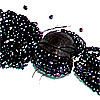
Beads that are 100 years or older are called antique beads. They are very rare, and can often only be purchased in deceased estate sales, or online from other enthusiasts. Antique beads can also be freed from buttons and decorations on old clothing that would otherwise not be that valuable, because of the deterioration of the fabric. How to identify antique beads? Older beads typically have larger holes. Modern manufacturing processes are able to create things on a smaller and more precise level, while older craftsmanship would produce holes of a larger scale. While holes tend to be much larger in antique beads, the tiny sized 16-24 seed beads are not produced in modern society. They take too much labor to make because of their minuscule size, but were made hundreds of years ago. They are only available today as antique beads. These tiny antique beads were used in the past for exquisite purses. Collectors would generally purchase this sized bead to admire. Such tiny seeded antique beads are very difficult to use. Each bead can only be sewn through once. They are very hard and fiddly to use in any project. Such small antique beads as these would most likely be purchased as part of another antique item. Their size means they wouldn't be sought after for contemporary beading projects. Antique beads should also have a surface that has been exposed to the environment over a long period of time. They should look aged and worn, but still in good condition. |
|
Narian-Mar, Latiffa and others
Don't wonder, please, Narian-Mar and Latiffa are the names of beadworks by Natasha Vysokinskaya, 33, who is our next guest today. Like many people, she rediscovered her artistic talent after a momentous event - in her case, the birth of her son and her subsequent retirement from work. As a child in Kharkov, Ukraine, Natasha was good in many crafts: sewing, knitting, cross-stitching, macrame and temari (the art of Japanese thread balls) but she had not thought to pursue crafts as a career. Instead she studied law and worked as a lawyer for a number of years. She married and two years before having a child left law to work as a staff manager in a large company. After her son's birth, her life took another direction. She began doing craftwork again and through the Internet discovered the world of beadwork. Her first creation in beadwork was a Firebird Brooch. Encouraged by the result, Natasha learned more about beading techniques and produced a lot of jewelry for her friends and family. Once she sold her first piece of jewelry there was no stopping her. Orders poured in and continue to pour in. Her signature is elegance and intricacy. She works primarily with beads and gemstones but likes experimenting with unusual materials such as leather cord, organza and even fur. (Note, especially the cuff bracelet embellished with gears and butterflies!) Natasha works in all color palettes and enjoys incorporating old jewelry parts into new creations. Now living in Minsk, Belarus, with her family, she has exhibited her work in Minsk and in Moscow, and photos of her work have appeared in magazines and craft books. When asked whether she has received awards, Natasha smiles and says that her greatest reward is her son's compliment: "Mom, you make such nice jewelry!"
Bead artwork by Natasha Vysokinskaya
|
|
Step by step. Brick stitch as 1-2-3
Another tutorial in series "1-2-3" by Victoria Katamashvili is about one of the most widespread beading techniques, brick stitch. Altogether with patterns, photos, and beadwork samples it can be pretty useful. You can try! |
|
Upcoming events
December 18, 19, 20, 2009 The International Gem & Jewelry Show offers the greatest selection and lowest prices on diamonds, gold, silver, beads, and more. Choose either costume or fine jewelry from more than 350 exhibitors from around the world. |
|
Note
If you don't see the newsletter properly formatted please click here:
November Issue
|
© 2010 MyLovelyBeads.com All Rights Reserved.
If you do not want receive our newsletter and you wish to remove your email address from our mailing list, please click the following link to unsubscribe.



